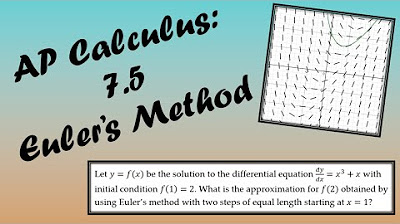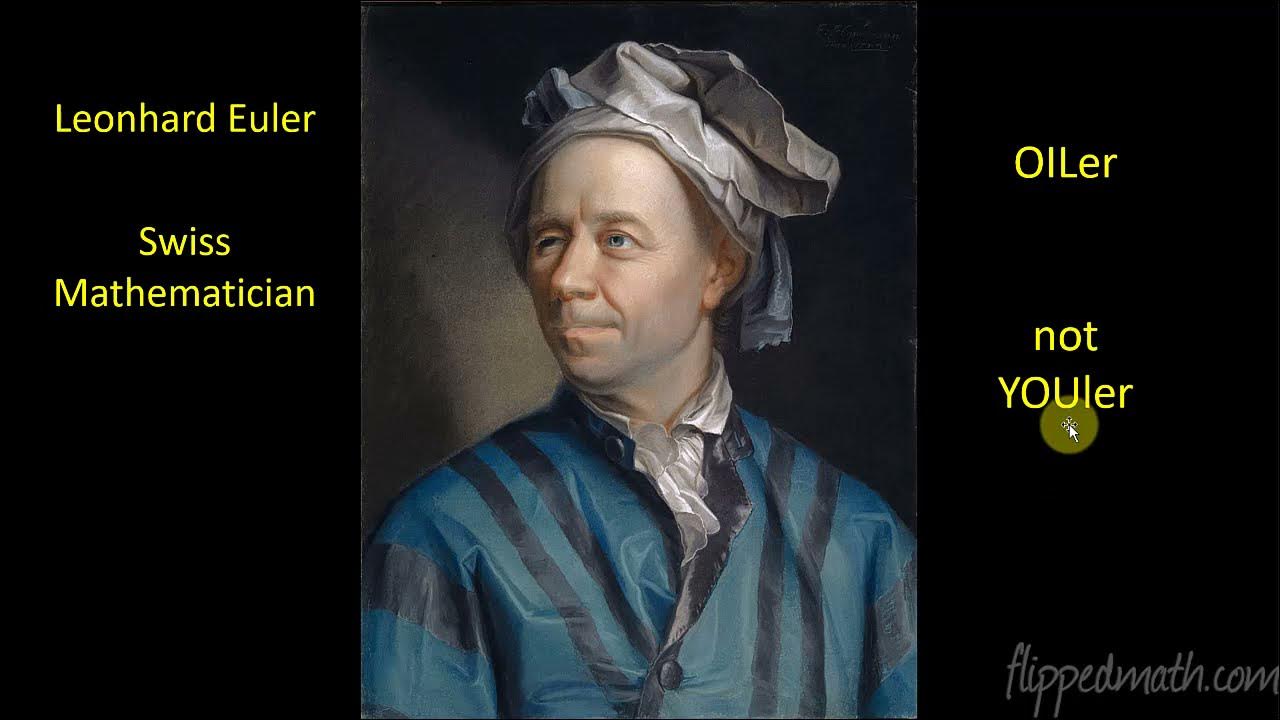Euler's Method
TLDRThis video tutorial delves into Euler's method, a numerical technique for approximating solutions to differential equations. The instructor illustrates the concept by sketching a solution curve and tangent lines, demonstrating the method's application with step-by-step calculations. The video compares the simplicity of the tangent line approximation to the enhanced precision of Euler's method, showcasing its effectiveness through examples. It also touches on the separation of variables for solving differential equations and concludes with an AP exam-style problem, reinforcing the method's practicality in educational contexts.
Takeaways
- 📚 Euler's method is a technique used to approximate solutions to differential equations.
- 📈 A slope field can help visualize the solution curve of a differential equation, which is essential for understanding the behavior of the function.
- 🔍 The tangent line at a point on the solution curve can be used to approximate the value of the function at nearby points, but it may not always be accurate.
- 🔄 Euler's method involves breaking the problem into smaller steps and using tangent lines to approximate the function's value at each step.
- 📉 The accuracy of Euler's method can be improved by taking smaller steps, as demonstrated in the video with a step size of 0.5.
- 🔢 The method requires calculating the slope at each point and using it to find the new point on the tangent line.
- 🧩 Euler's method can be applied in multiple steps, with each step providing a better approximation of the function's value.
- 📌 The video provides a step-by-step example of using Euler's method to approximate the value of a function at x=1, starting from x=0.
- 📘 Separation of variables is another method discussed for solving differential equations, which involves manipulating the equation to isolate variables.
- 📚 The video also covers how to find the second derivative of a function and use it to determine the nature of a critical point (maximum, minimum, or neither).
- 📝 The script includes examples from AP calculus exams, demonstrating the practical application of Euler's method and other calculus concepts in exam settings.
Q & A
What is Euler's method used for?
-Euler's method is a numerical technique used to approximate solutions to differential equations.
What is the purpose of sketching a solution curve for a differential equation?
-Sketching a solution curve helps to visualize the behavior of the solution and to approximate its path within the slope field without contradicting the slope field's tick marks.
How does the slope field influence the accuracy of the tangent line approximation?
-The slope field provides information about the rate of change of the solution. If the slope changes significantly within the interval, the tangent line approximation may not be very accurate.
What is the main idea behind Euler's method?
-Euler's method involves breaking down the interval into smaller steps and using the slope at each step to approximate the solution at the next point, thus refining the approximation by 'checking back' with the slope field.
Why might the tangent line approximation at x equals 1 be inaccurate?
-The tangent line approximation at x equals 1 might be inaccurate because the slope of the function changes significantly between x equals 0 and x equals 1, causing the tangent line to not closely follow the actual solution curve.
How does Euler's method improve upon the tangent line approximation?
-Euler's method improves the approximation by taking multiple steps, each time adjusting the approximation based on the slope at the new point, which provides a more accurate prediction of the function's value at subsequent points.
What is the significance of the step size in Euler's method?
-The step size in Euler's method determines the granularity of the approximation. Smaller step sizes can lead to more accurate results but may require more computations.
How does the script illustrate the process of Euler's method using a specific example?
-The script uses a differential equation with an initial condition to demonstrate Euler's method step by step, showing how to calculate the approximate value of the function at a specific point by taking equal steps and adjusting the tangent line accordingly.
What is the role of the cosine function in the example provided in the script?
-In the example, the cosine function is used to determine the slope of the tangent line at specific points, which is crucial for calculating the next point in the Euler's method approximation.
How does the script relate Euler's method to the process of separation of variables in solving differential equations?
-The script briefly mentions separation of variables as an alternative method to solve differential equations analytically and contrasts it with Euler's method, which is a numerical approach to find approximate solutions.
What is the significance of the second derivative in the context of the script?
-The second derivative is used to determine the concavity of the function, which can indicate whether a point is a maximum, minimum, or neither. It is used in the context of analyzing the behavior of a solution to a differential equation.
How is the 'l'Hôpital's rule' mentioned in the script relevant to solving a limit involving a differential equation?
-L'Hôpital's rule is used to evaluate limits that involve indeterminate forms, such as 0/0 or ∞/∞. In the script, it is applied to find the limit of a function as x approaches a certain value, which is part of solving a differential equation problem.
What is the final example in the script about and how does it demonstrate Euler's method?
-The final example is a problem from an exam that demonstrates how to use Euler's method with two steps of equal size to approximate the value of a function at a specific point, starting from an initial condition and using the derivative of the function to find successive points.
Outlines
📚 Euler's Method Introduction and Basic Concept
This paragraph introduces Euler's method, a numerical technique for approximating solutions to differential equations. It begins with a scenario where a differential equation and its slope field are given, and a rough sketch of the solution curve is made, starting from the point (0,1). The importance of aligning the sketch with the slope field's tick marks is emphasized, without needing a perfect drawing. The paragraph also explains the process of finding the equation of the tangent line to the solution curve at x=0, using the slope at that point, and how this tangent line can be used to approximate the function's value at x=1. However, it acknowledges the large error in this approximation due to the significant change in the slope (d y d x) from x=0 to x=1, as illustrated by the slope field. The paragraph concludes by introducing the concept of Euler's method as an improved way to approximate the function's value by checking back with the slope field at intermediate steps, rather than relying solely on the tangent line approximation.
🔍 Implementing Euler's Method with an Example
The second paragraph delves into the practical application of Euler's method using a specific differential equation. It outlines the process of approximating the value of a function at x=1, starting with known information at x=0. The method involves breaking the interval into equal steps and using the slope at each step to calculate the next point on the function's curve. The example provided uses two steps of equal size, from x=0 to x=0.5 and then from x=0.5 to x=1, and it includes the calculation of the tangent lines and the points where they intersect the x-axis. The paragraph also highlights the importance of using the same delta x for each step to ensure the method's accuracy. It concludes with a comparison of the approximation obtained from Euler's method to the true value of the function, showing that Euler's method provides a much better approximation than the simple tangent line method.
📘 Euler's Method in AP Calculus and Separation of Variables
This paragraph discusses the application of Euler's method in the context of AP Calculus exams, providing an example from an old AP calculus course description. It explains how to use Euler's method with a step size of 1.5 to approximate the value of a function g at x=2, starting from g(-1)=-2. The process involves calculating the slope at the starting point and using it to find the next point on the curve, then repeating the process for the second step. The paragraph also touches on the importance of checking the consistency of the delta x used in the approximations. Additionally, it provides a brief refresher on the method of separation of variables, explaining how to rearrange and integrate both sides of a differential equation to find the function's explicit form. The paragraph concludes with an example of finding the explicit form of a function using separation of variables and an initial condition to determine the constant of integration.
📘 Euler's Method Application in Exam Scenarios
The fourth paragraph presents an example of Euler's method from the 2016 BC AP exam, which includes a free response question with multiple parts. It begins with a discussion on finding the second derivative of a given function in terms of x and y, which is used to analyze the behavior of the function at a specific point. The paragraph then moves on to examine whether a function has a maximum, minimum, or neither at a given point by evaluating the first and second derivatives at that point. The next part of the paragraph involves using L'Hôpital's rule to evaluate a limit, which requires multiple applications of the rule due to the indeterminate form. Finally, the paragraph concludes with an Euler's method example, where two steps of equal size are used to approximate the value of a function h at x=1, starting from x=0. The process involves calculating the slope at each step and using it to find the next point on the curve, resulting in an approximation that is expected to be closer to the true value than a single-step tangent line approximation.
Mindmap
Keywords
💡Euler's Method
💡Differential Equation
💡Slope Field
💡Tangent Line
💡Error
💡Approximation
💡Separation of Variables
💡Anti-Derivative
💡L'Hôpital's Rule
💡Free Response Question
💡Second Derivative
Highlights
Introduction to Euler's method for approximating solutions to differential equations.
Explanation of how to sketch a solution curve for a differential equation using a slope field.
Demonstration of how the graph of a function can be approximated using tangent lines.
Discussion on the limitations of using a single tangent line for approximation and the error involved.
Introduction of Euler's method as an iterative process to improve approximation accuracy.
Use of cosine values in the approximation process for a specific differential equation.
Step-by-step application of Euler's method with a two-step equal size example.
Calculation of the approximate value of a function at a specific point using Euler's method.
Verification of the approximation process by ensuring consistent step sizes in Euler's method.
Comparison of Euler's method with the tangent line approximation and the improvement in accuracy.
Brief explanation of separation of variables in solving differential equations.
Derivation of the general solution for a given differential equation using separation of variables.
Application of initial conditions to find the specific solution in a differential equation.
Example of using Euler's method in an AP Calculus exam scenario with a step size of 1.5.
Detailed calculation of the approximate value of a function using a two-step Euler's method in an exam example.
Discussion on finding the second derivative of a function in terms of x and y.
Analysis of the concavity of a function to determine if it has a maximum, minimum, or neither at a specific point.
Application of L'Hôpital's rule in a limit problem related to a differential equation.
Final example of applying Euler's method to approximate the value of a function at a specific point with a detailed calculation.
Transcripts
Browse More Related Video
5.0 / 5 (0 votes)
Thanks for rating:





